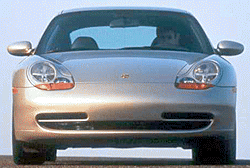 |
 |
The new Porsche 911 Carrera may be equipped with either a manual transmission or, as an extra-cost option, Tiptronic S automatic gearbox driving a limited-slip differential. Both transmissions have been substantially refined and changed from their predecessors.The manual gearbox is more compact than its predecessor, has six forward speeds with closer gear ratios than before, and is equipped with a hydraulically operated clutch and cable-actuated shift mechanism. The optionally available Tiptronic S has five forward speeds, a lock-up torque converter, revised shift console pattern from previous models, steering wheel spoke actuator buttons for manual operation, and five automatic shift mode programs for specific driving styles and conditions.
As with the Boxster, the Carrera uses a dual-mass engine flywheel and a cable-type shift mechanism to isolate the driver and the shift lever from movement and noise from the manual transmission. The ergonomically designed aluminum shift knob follows a four-column shift pattern.
The six-speed gearbox features full synchronization, including reverse, with external dual-cone synchronizers. To better take advantage of the new engine's torque and power characteristics, the 911's gear ratios have been altered from the previous model, though its final drive remains the same. Sixth gear is an overdrive, and the car's top speed is attained in sixth.
As on the previous 911 and the Boxster, the Tiptronic S offers the driver choice of allowing the transmission to shift through the gears automatically or to manually shift up and down. For 1999, the Carrera's Tiptronic S, like the unit in the Boxster, has five forward gears, with closer gear spacing than before, for better use of the engine's power and torque. Fourth gear is a direct 1:1 drive, while fifth is an overdrive for reduced fuel consumption and noise while cruising. Leaving the gear selector in "D" allows the transmission to operate like other automatic transmissions, while moving to "M" means the steering wheel spoke mounted buttons control up- and downshifts according to driving style and conditions.
When left in the fully automatic drive setting, the Tiptronic S bases its gear changes on inputs from several electronic sensors. There are five distinct shift "maps" programmed into the Tiptronic's electronic control unit. Based on the driver's style and the driving conditions, the control unit adapts the appropriate program . To further ensure smooth shifts, the electronic control units of the Tiptronic S and the engine work together to briefly suppress engine ignition during each shift.
For 1999, the Carrera may also be equipped with Porsche's automatic brake differential (ABD). This extra-cost option is a traction control system to help start the car moving on slippery surfaces. The system relies on both the ABS and engine management electronic control units to apply and release the brakes (cycling in fractions of a second) to prevent each driving wheel from spinning. ABD also prevents the two driving wheels from spinning concurrently by adjusting both the ignition and fuel injection to reduce engine power.
![[email image]](../Graphics/email.gif)
. Copyright ©1995-98 by AUTOPEDIA, all rights reserved. AUTOPEDIA™, AUTO411™, CAR-IQ™, DEALERPEDIA™, UNILOT™, SIMULSEARCH™ and INTERQUOTE-RFP™ are trademarks of AUTOPEDIA. All other trademarks, tradenames and/or service marks are the property of their respective holders. Although all information and prices contained herein are obtained from sources deemed to be reliable, AUTOPEDIA assumes no responsibility for the accuracy of the information and no liability for any errors and/or omissions. All information is subject to change without notice.